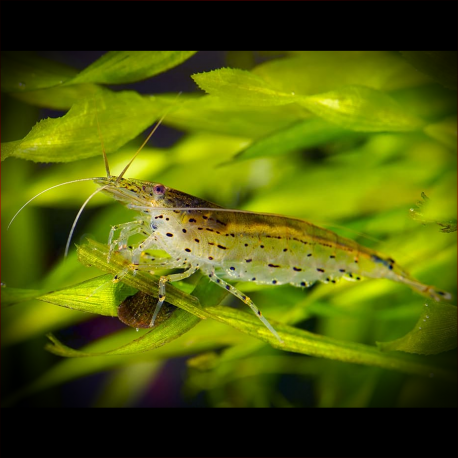More info
Datasheet
| Minimum Tank Size | 40 litres / 10.57 US gallons |
| Maximum Size | 5.1cm / 2.01inches |
| Temperament | Peaceful |
| Care Description | Easy |
| Temperature | 15.6°C / 60.08°F - 26.7°C / 80.06°F |
| Carbonate Hardness | 3-10 |
| pH | 6.0-7.6 |
General Description
The Japonica Amano Shrimp, also known as Amano Shrimp, is valued for its appetite for various freshwater algae, detritus, and leftover fish food. Sporting an opaque brown body color with a distinctive tan stripe along its back and broken horizontal lines on its sides, this species is a popular choice for aquarium enthusiasts. Originating from Japan, it is also referred to as Yamato Numa-Ebi or Japanese Swamp Shrimp.
Aquarium Setup
For optimal care, the Amano Shrimp thrives in a well-established freshwater aquarium or pond of at least 10 gallons, rich in algae and with a mature substrate. The setup should include ample hiding spots and peaceful tank mates ensuring the shrimp's safety. Interestingly, these shrimps can adapt to low to moderate salinity levels, making them suitable for algae control in non-freezing climate ponds and water gardens.
Behaviour
Possessing a peaceful temperament, the Amano Shrimp is an efficient cleaner that scavenges algae, detritus, and uneaten fish food. This shrimp species is captivating to observe as it moves around the aquarium, diligently foraging for food and exhibiting its natural behaviors.
Feeding and Diet
Being omnivorous, the Japonica Amano Shrimp sustains itself by consuming a diet primarily consisting of algae, detritus, and leftover food. In cases of inadequate food supply, supplementing their diet with high-quality flake food or pellets is recommended to ensure their nutritional requirements are met.
Reproduction & Dimorphism
The Amano Shrimp proves challenging to breed in captivity, with few hobbyists successfully raising the larvae to maturity. These shrimps have an average lifespan of 2 to 3 years when well-cared for in a suitable habitat.
Habitat and Distribution
In their natural habitat, Amano Shrimps inhabit the swamps of Japan, thriving in freshwater environments. Due to their robust nature and adaptability, they make excellent additions to freshwater aquariums and ponds, contributing to the ecosystem by serving as efficient algae controllers.

